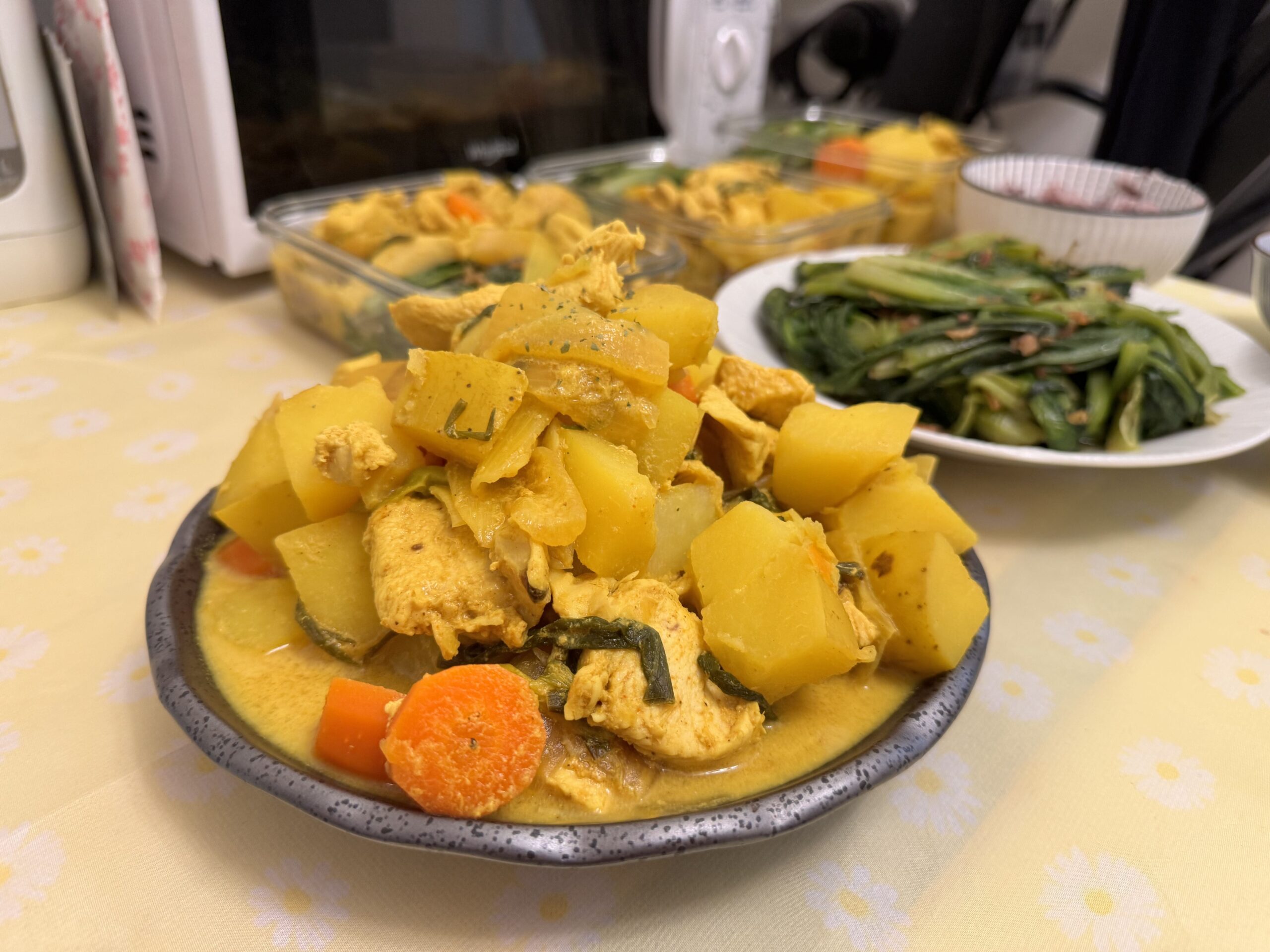Sometimes, a velvety, and aromatic coconut curry is exactly what you need. Balance out the rich sauce with chicken breast to indulge in a lower calorie comfort meal.

Time: 3/5
Chicken breasts actually taste better with less cooking, not more
Effort: 3/5
Store bought curry powder saves on a lot of work.
All Gravy
Growing up, few things were as comforting as a classic Hong Kong style curry over rice. Like Malaysian style curry, the dominant flavour is that of the copious amount of coconut milk. It’s not as spicy as an Indian curry, and not as sweet as Japanese curry. For me, it tastes just right.
Curry and rice is like gravy and potatoes. One part of the duo brings the flavour, while the other provides the substance and the stage on which the tastes and aromas can dance. The classic protein of choice is probably beef brisket that has been braised until it’s fork-tender, but chicken thighs are also a common choice.
But the classic recipe is a bit too rich to be an everyday meal. Now that I take fitness and health more seriously, I’m always looking for ways to make traditional comfort foods align with my nutritional goals.
The way I achieve this with coconut curry is by using chicken breasts instead of higher fat protein sources, and by cutting the amount of coconut milk I use with some water. I won’t claim that it’s just as good as the original, but it’s close enough that it still scratches the same itch.
Curry powder mix is so widely available here that everyone just buys it at the store. But if you want (or have) to make it from scratch, here are the ingredients listed on the back of the packet:

Or in English: turmeric, star anise, cinnamon, cumin, ginger, cloves, and chili powder. Guessing from the colour, it’s probably listed in order of proportion i.e. It’s mostly turmeric.
If you’re not afraid of putting in more work, you can upgrade the base recipe is to turn it into a casserole. Make the same curry but with 100% coconut milk and some nice, fatty cuts of beef like brisket. Get cooked rice (or better yet, fried rice) in the bottom of a baking dish, ladle the curry over it, top with some cheese and broil it in the oven to get a rich and aromatic curry bake that stays warm for a good while. Perfect meal for a winter bulk!

Posts since the last recipe that was actually served with rice: 0
Dramatis Personae
Served 5.
- 1kg chicken breast
- 2 large potatoes, about 600g
- 1 medium carrot
- 1 onion
- 2 bunch of spring onions
- 1 tbsp garlic paste
- 1 tbsp ginger paste
- 12g curry powder mix
- 250ml coconut milk
- Fish sauce and sugar to taste
Served with 1200g of Indian lettuce. Always eat your veggies!

Executive summary
- Get the ingredients together. Wash and cut the root vegetables.
- Heat oil in a pan. Stir fry root vegetables, curry powder, and the garlic and ginger paste until fragrant.
- Add water and cover, simmer until potatoes and carrots are almost tender. Slice chicken breast into thin pieces in the meantime.
- Once vegetables are almost done, stir in the chicken.
- After several minutes, add coconut milk. Season to taste, adjusting the sweetness and salinity with sugar and fish sauce.
- Serve hot, with rice.
Play by Play

Getting the knife work out of the way. I like to keep the potato skins on for some extra fiber, but that means I have to scrub them very well. Also, I hoped the red onion might add a bit of colour to the dish but it didn’t matter in the end.



Let’s get the vegetables done while the pan is nice and clean. Indian lettuce, cleaned and cut into a manageable size, stir fried with some of my aunt’s XO sauce for that awesome umami goodness.

Vegetables out, and I don’t even bother to clean. The curry is strong enough that flavour ‘contamination’ isn’t an issue at all. Root veg and aromatics go in, to be stirred around until it smells fragrant.



Now that there’s plenty of mass in the pan, I’m not worried that the curry powder will burn. Stir that in as well, and once you can smell it add water and cover to simmer.


While waiting for the potatoes to cook, I cut the chicken breast into relatively thin pieces. Once the potatoes are tender, the chicken gets stirred into everything else and left to simmer gently for a few minutes.

Wait until the last minute to stir in the coconut milk, so it’s less likely to be split by the heat. This is a pretty conservative amount of coconut milk – the more you add, the tastier the curry will be, but of course with more calories.

Dinner is served! If I was making a lot of portions, I might box up the curry on the bottom and keep the rice on top. But this batch will all be eaten soon, so I’m not worried that the rice will become soggy.

Rice mandatory, for soaking up all that gravy – serving with some crusty bread to mop up the curry would also be a great idea.
Thanks for subscribing! See you around.
Keep browsing by categories, or by tags:
Beef Blog Broccoli Cabbage Carrots Cast iron Cheese Chicken Curry Dashi Date Night Dried scallops Dried shrimp Eggs Fish and seafood Garlic Ginger Glass noodles Gochujang Honey Miso Napa cabbage Onion Oven Pasta Pork Potatoes Salmon Sesame oil Shiitake mushrooms Shrimp Soup Sous Vide Steaming Stewing Stir fry String beans Sweet potatoes Teriyaki Tofu Tomatoes Vacuum cooker Vegetarian Yogurt Zucchini
